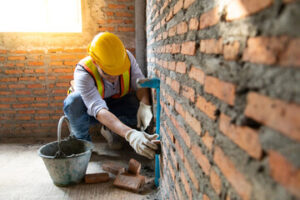Masonry work adds beauty and durability to a home. It also increases property value. However, homeowners should be careful when choosing a mason to avoid scams and poor workmanship.

The expertise of masonry contractors is an essential factor to consider when choosing a company for your renovation project. Ask for references and work samples from previous clients to see if the contractor is able to produce quality results that align with your vision and goals for your renovation. In addition, make sure that the contractor has a license in your area and is insured to protect you from liability should an accident occur during construction. Contact Masonry Contractors Charleston SC for professional help.
Masonry experts have extensive knowledge of different masonry techniques and materials, which allows them to construct or repair structures with precision. They also have strong problem-solving skills and are able to address unexpected issues that may arise during the renovation process. This expertise contributes to a smooth and efficient project completion.
Investing in a skilled masonry contractor is an excellent way to increase your property value and enhance its visual appeal. Aesthetically pleasing brick or stone façades and custom outdoor living spaces elevate your home’s curb appeal and add to its structural integrity, resulting in higher market value when you decide to sell.
In addition, well-executed masonry work is long-lasting and requires minimal maintenance, which makes it a cost-effective investment for the lifespan of your property. In contrast, DIY projects can end up costing you more in the long run because of mistakes and faulty workmanship.
When selecting a masonry company, ask for a detailed quote that includes the scope of work, materials, and timelines. You should also consider if the company offers a warranty on their work and materials, as this is an indication of their confidence in their abilities. A warranty is especially important if you’re working with an inexperienced contractor.
Another important thing to look for in a masonry company is their level of professionalism and customer service. Make sure they are courteous, responsive, and willing to answer any questions you may have. Lastly, check whether they clean up after themselves and leave your home in the same condition as it was when they arrived. This is a sign of integrity and demonstrates their respect for you and your home.
Licenses
Depending on the locale, Masonry Contractors may need to be licensed in order to accept jobs. This can include a general contractor’s license or a specific masonry license, depending on the area in which they work. In addition, they may need to obtain permits for the job. This is typically handled by smaller jurisdictions like cities, towns and municipalities and is done on a case-by-case basis.
While most masons can work with a wide variety of materials, some specialize in certain types of projects or in particular kinds of material. This can be beneficial, as they can often bring a wealth of experience and expertise to a project that might otherwise be challenging.
When selecting a Masonry Contractor for your commercial construction, add-on or repair project, ask them about the type of projects they have worked on in the past. They should be able to point you toward the site of previous projects that have been completed in your area and provide examples of their work.
It’s also important to discuss the insurance requirements of your upcoming project. Depending on your location, you may need to have liability and property damage coverage, as well as workers’ compensation coverage. You should also find out who is responsible for hauling away any debris from the job site. In addition, you should agree on a payment schedule. Usually, there is an upfront deposit and then partial payments are made based on the percentage of the project that has been completed.
In New York State, there are no formal certification requirements for masons. However, it is recommended that aspiring masons take part in formal training programs at colleges and vocational schools. These programs will teach masonry workers both the functional and business aspects of the craft. They will also provide hands-on training and mentorship from established masons.
In the state of Oregon, the process to become a licensed Masonry Contractor takes 1463 days (4 years and 3 days). It requires $310 in fees, 1 exam, 4 years of experience and 16 clock hours education. A license isn’t necessarily a guarantee that the contractor will be competent, but it can give you some peace of mind.
Insurance
Masonry Contractors work with the literal foundations of people’s livelihoods, whether that’s houses or skyscrapers. That makes their job incredibly important, but it also exposes them to unique risks. These risks underscore the necessity of comprehensive masonry insurance. Personalized masonry insurance protects businesses from common hazards, keeping them operating safely and successfully.
Liability protection is the core of masonry insurance, covering damages from third-party accidents and injuries caused by a company’s work. It can cover lawsuits, settlement costs, and judgment awards. It’s often required for contractors to have this coverage before being hired for a project. Additional coverage options for masonry professionals include commercial umbrella insurance, which activates when the underlying liability policy reaches its limit. This provides an extra layer of defense and can help meet contractual demands for higher limits.
Workers’ compensation insurance is another vital component of masonry insurance. It covers medical bills, physical rehabilitation, and a portion of lost wages for employees who are injured in the course of their duties. In many states, workers’ compensation insurance is mandated for all employers.
Inland marine insurance is a must-have for masonry contractors, as it protects tools and equipment against damage or theft while they’re in transit between job sites. It can be combined with a general commercial auto insurance policy for added protection. Commercial auto insurance usually includes property and liability protection, as well as state-required coverage like no-fault/personal injury protection and uninsured motorists coverage.
Depending on the size of a masonry business, additional policies may be necessary. For example, a surety bond can reimburse clients if a contract isn’t fulfilled by the contractor. It’s a requirement for some projects, and it can help improve a company’s reputation in the industry.
References
Masonry contractors are experts at working with concrete, stone, and other types of masonry construction. They use their expertise to help clients establish project requirements and goals, create architectural and structural plans, prepare the construction site, and select materials for the building.
Before hiring a masonry contractor, ask them for references from past clients and professional associations. You can also check online reviews to learn about a potential contractor’s reputation. A high number of positive reviews indicates that a contractor provides quality work and offers a great customer experience.
In addition to customer reviews, you can also ask a potential contractor for photos of previous projects they’ve completed. This will give you a better idea of their skill level and whether their work aligns with your vision for the project. It’s also helpful to discuss the project timeline with a masonry contractor. Unforeseen circumstances can delay any construction project, but it’s important to have a clear understanding of how long the project is expected to take so that you can plan accordingly.
The best masonry contractors will stand behind their work and offer a guarantee or warranty. This is an indication that they believe in the craftsmanship and artistry of their work, and that they are willing to invest time and money into making sure it is done right.
Another important consideration is whether or not a masonry contractor has insurance coverage. This is crucial to protect you from any liability should an accident occur during the construction process. In 2018, nearly 24% of workers in the construction industry were without health insurance, and a masonry contractor without proper insurance may not be covered in the event of an injury or property damage. In addition, many states require masonry contractors to carry insurance in order to operate a business. This requirement ensures that customers are protected from any unforeseen events and provides peace of mind for all parties involved. If a masonry contractor is not insured, you should look for a different provider.

